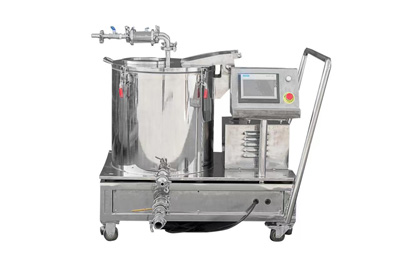Industrial Centrifuges: Types and Capacities
As experts in industrial equipment, we’re excited to share our insights on industrial centrifuges. These machines are vital in many industries, helping us separate solids from liquids or different liquids based on density. Using powerful centrifugal force, industrial centrifuges make processes smoother and more efficient. In this post, we’ll dive into the types of industrial centrifuges, explore industrial centrifuge capacity, and highlight some products from Reyes Centrifuge. Let’s get started!
What Are Industrial Centrifuges?
Industrial centrifuges spin mixtures at high speeds to separate components. The heavier parts move outward, while lighter ones stay near the center. This simple yet effective method is key in industries like wastewater treatment, chemicals, and oil refining. At Reyes Centrifuge, we see how these machines improve productivity and quality every day.
Types of Industrial Centrifuges
There are two main types of industrial centrifuges: filtration and sedimentation. Each has a unique design and purpose, so let’s break them down.
Filtration Centrifuges
Filtration centrifuges use a basket with tiny holes. As the basket spins, liquids pass through, but solids stay behind. We find this type perfect for collecting solids or clarifying liquids.
Some examples include:
- Perforate Basket Centrifuge: Great for small batches, often used in hemp washing.
- Pusher Centrifuge: Built for continuous work, handling large amounts of material.
- Peeler Centrifuge: Ideal for dewatering solids in chemical industries.
One product we love from Reyes Centrifuge is the HHP-15. It’s designed for hemp washing with ethanol, with a drum diameter of 300 mm and a volume of 15 liters. It spins at 2000 r/min and uses a 1.1 KW motor, making it efficient for small-scale tasks.
Sedimentation Centrifuges
Sedimentation centrifuges have a solid bowl instead of holes. Solids stick to the bowl’s walls as the machine spins, while liquids flow out through an outlet. We use these for fine particle separation and high clarity.
Common types are:
- Decanter Centrifuge: Perfect for wastewater treatment, handling lots of sludge.
- Disk-stack Centrifuge: Known for great efficiency in food processing.
- Tubular Bowl Centrifuge: Used in biotech for tiny particle separation.
A standout from Reyes Centrifuge is the LW/LWS250*1000. It has a 250 mm diameter, spins at 5000 r/min, and handles 0.5-5 m³/h. It’s a solid choice for smaller wastewater jobs.
Industrial Centrifuge Capacity
When we talk about industrial centrifuge capacity, we mean how much material a machine can process. This varies widely depending on the model and purpose. At Reyes Centrifuge, we offer options for all scales.
For filtration, the HHP series ranges from small to large. The HHP-15 holds 15 liters and processes 5 kg per batch. Need more? The HHP-145 handles 145 liters and 45 kg per batch. This flexibility in industrial centrifuge capacity helps us match the right machine to the job.
For sedimentation, the LW/LWS series shines. The LW/LWS250*1000 manages 0.5-5 m³/h, while the LW/LWS800*3200 tackles 20-120 m³/h. This range in industrial centrifuge capacity ensures we can support everything from small plants to big factories.
Product Spotlight: Reyes Centrifuge Offerings
We’re proud to showcase some products from Reyes Centrifuge. These machines are built with quality and performance in mind.
- HHP-15 (Filtration): With a 300 mm drum, 15-liter volume, and 2000 r/min speed, it’s perfect for hemp washing. It weighs 230 kg and includes features like an explosion-proof motor and touch screen controls.
- LW/LWS250*1000 (Sedimentation): This model has a 250 mm diameter, 1000 mm length, and a 7.5 KW motor. It’s compact at 21201250680 mm and handles up to 5 m³/h.
Both are made with 304 and 316L stainless steel, rated for -70℃, ensuring durability and versatility.
Comparing Filtration and Sedimentation Centrifuges
The types of industrial centrifuges differ mainly in their bowls. Filtration centrifuges have a basket with holes, letting liquids pass through. Sedimentation centrifuges use a solid bowl, relying on force to separate everything. We notice sedimentation types often give higher efficiency for fine particles, while filtration is simpler for bigger solids.
Where We Use Industrial Centrifuges
Industrial centrifuges are everywhere! We see them in:
- Wastewater Treatment: Cleaning water by removing sludge.
- Oil and Energy: Separating water from crude oil or biofuels.
- Chemical: Purifying products for better quality.
- Pulp and Paper: Processing fibers efficiently.
Their wide use shows how essential they are to us.
FAQ: Your Questions Answered
Here are some common questions we hear about industrial centrifuges:
What’s the difference between filtration and sedimentation centrifuges?
Filtration uses a basket with holes to catch solids, while sedimentation uses a solid bowl to separate by density.
How do we pick the right centrifuge?
We look at material type, capacity needs, and industry goals. Reyes Centrifuge experts can guide us too.
What’s the biggest industrial centrifuge capacity?
It depends, but models like the LW/LWS800*3200 handle up to 120 m³/h for big tasks.
Are these machines easy to maintain?
Yes, with proper care, our Reyes Centrifuge models are built to last and run smoothly.
Wrapping Up
Exploring the types of industrial centrifuges and their capacities shows us how vital they are. Whether it’s the HHP series for filtration or LW/LWS for sedimentation, industrial centrifuge capacity meets every need. At Reyes Centrifuge, we’re committed to providing top-notch solutions. Next time you’re tackling a separation challenge, we hope you’ll think of these incredible machines!













